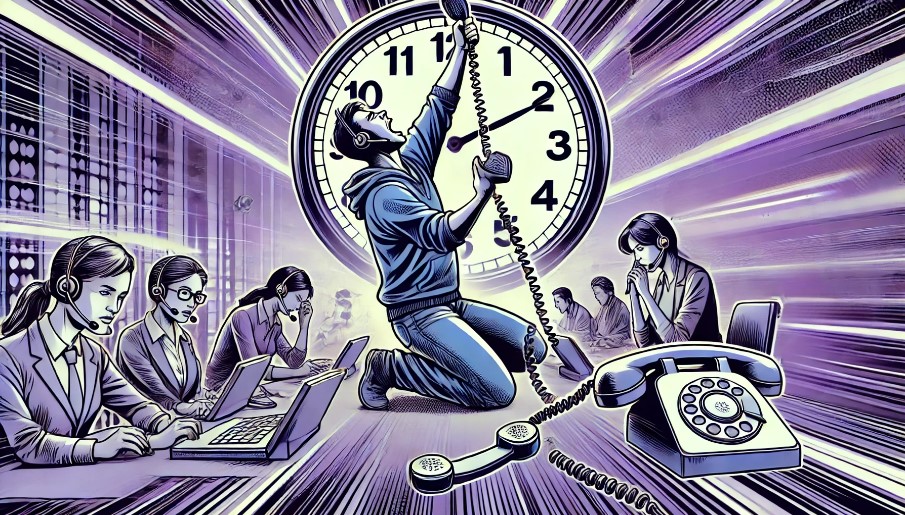A Complete Guide to Lowering Call Abandonment Rates
01 Nov 2023 By: Michael Kansky
Updated
In today’s digital age, customer expectations are sky-high. One key metric businesses can’t ignore is the call abandonment rate (CAR). This rate shows how many customers hang up before talking to a service rep. It’s a measure of customer happiness and reflects a business’s efficiency and service quality. Lowering CAR is vital for improving customer experience, boosting your brand, and driving success. This guide will explore CAR in depth. We’ll look at its effects on businesses and share strategies to decrease it. This ensures customers stay happy and engaged.

Understanding Call Abandonment Rates
Before we dig deeper, let’s define call abandonment. It happens when customers, fed up with long waits or poor call routing, hang up without help. This metric is a percentage. You find it by dividing abandoned calls by all incoming calls.
How to calculate Call Abandonment Rate
Keep in mind, formulas can vary based on your business and service aspect you’re assessing. Typically, you calculate it by dividing abandoned calls by total incoming calls (or other call variations) and then multiply by 100% for the percentage. It’s also wise to consider the story behind the numbers, not just the abandonment rate itself. Here are some call abandonment rate formula.
Direct Calculation Method
Call Abandonment Rate = (Total Number of Abandoned Calls / Total Number of Incoming Calls) x 100%
Using Service Level
Call Abandonment Rate = (Total Number of Abandoned Calls / (Total Number of Answered Calls + Total Number of Abandoned Calls)) x 100%
Calculation including Calls Answered Within a Specified Time
Call Abandonment Rate = (Total Number of Abandoned Calls – Calls Answered Within Specific Time / Total Number of Incoming Calls – Calls Answered Within Specific Time) x 100%
The Overall Abandonment Rate
Call Abandonment Rate = (Total Number of Abandoned Calls in Queue + Total Number of Abandoned Calls During Hold) / (Total Number of Incoming Calls) x 100%
What is Call Abandonment?
Call abandonment happens when customers hang up before they can talk to customer service. This can be due to long waiting times, complex call menus, or bad experiences with service agents.
Let’s take a closer look at some of the common factors that contribute to call abandonment:
- Long Wait Times: When customers are put on hold for extended periods, their patience wears thin. They may choose to abandon the call rather than wait any longer.
- Inefficient Call Routing: If customers are constantly transferred from one department to another without finding a resolution. They may become frustrated and abandon the call out of sheer frustration.
- Complex Call Menus: Complicated and confusing call menus can confuse customers. Making it difficult for them to navigate the options and find the right department or service they need. This confusion can lead to call abandonment.
- Poor Previous Interactions: If customers have had negative experiences with customer service agents in the past, they are more likely to abandon calls in the future. Fearing a similar unsatisfactory outcome.
Why Call Abandonment Rates Matter
Call abandonment rates show how happy customers are. High rates mean customers are unhappy, leading to less loyalty and bad reviews. It’s key for businesses to work on lowering these rates to keep customers happy and loyal.
Reducing call abandonment rates can have several benefits for businesses:
- Improved Customer Satisfaction: By minimizing call abandonment, businesses can ensure that more customers receive the assistance they need, leading to higher levels of customer satisfaction.
- Enhanced Brand Reputation: When customers have positive experiences with customer service, they are more likely to view the brand in a favorable light. This can contribute to a strong brand reputation and positive word-of-mouth recommendations.
- Increased Customer Loyalty: When customers feel valued and supported, they are more likely to remain loyal to a brand and continue doing business with them in the long term.
- Higher Customer Retention: By addressing the factors that contribute to call abandonment, businesses can improve customer retention rates, reducing the need to constantly acquire new customers.
Trending Now
An article from CMSWire highlights how vital call center metrics are in satisfying modern consumers’ demands for quick, precise customer service. A Talkdesk report shows 58% of consumers have higher expectations now. A critical metric, the average call abandonment rate, shows the share of callers hanging up before talking to an agent. This rate points to customer frustration from long waits and stresses the need for call centers to refine their operations to avoid losing customers to rivals.
The Impact of High Call Abandonment Rates
High call abandonment rates can have far-reaching consequences for businesses. Let’s explore three key areas where these rates can have a significant impact.
On Customer Satisfaction
Long waits and multiple tries to reach support frustrate customers, hurting satisfaction. This can damage a business’s image and reduce its ability to keep or gain loyal customers.
Imagine a scenario where a customer with an urgent issue calls support, expecting fast help. But high abandonment rates lead to a long hold. Their frustration builds, making them doubt the company’s service commitment. This bad experience impacts their view of the whole business.
Furthermore, unhappy customers often share bad experiences online. In our connected world, one upset customer can spread negativity fast on social media and reviews. This can scare off potential customers and hurt the business’s reputation over time.
On Business Reputation
High call abandonment rates show poor customer service, which can hurt a business’s reputation. Potential customers may see this as a sign of unreliability and professionalism. If someone finds a business with frequent abandoned calls, they might doubt its ability to provide timely support or meet their needs.
Negative reviews tied to call issues can also harm the business. In the digital age, online reviews influence buying decisions. If customers see complaints about call experiences, it can quickly lower trust and drive them away.
On Operational Efficiency
High call abandonment rates lower efficiency, increasing costs and reducing productivity. Companies may need extra resources to manage dropped calls, which leads to higher expenses and overworked staff.
When call handling struggles, it highlights inefficiencies. Fixing this requires hiring more staff or upgrading call systems, both of which cost money. Overloading customer service reps can cause burnout and reduce productivity.
Lost calls also mean missed opportunities. Each abandoned call could have led to a sale or partnership, affecting growth. In short, reducing call abandonment is essential for improving customer satisfaction, maintaining reputation, and boosting efficiency.

Identifying Causes of High Call Abandonment Rates
Understanding the causes behind high call abandonment rates is crucial to addressing the issue effectively. Let’s explore some of the common reasons customers may abandon calls.
Long Wait Times
Long waits with repeating hold music or messages can frustrate customers, leading them to hang up. Being on hold for ages, hearing the same tune, can test anyone’s patience. Customers might feel their time is wasted and hang up. Plus, interrupting messages like “Your call is important to us” can make them feel ignored, raising the chance they’ll abandon the call.
Inefficient Call Routing
Customers who can’t quickly reach the right department may hang up due to discouragement. Poor call routing that sends calls to the wrong place can increase hang-ups. Imagine selecting options on a call, only to end up in the wrong department. This frustration can make customers feel the company is disorganized and prompt them to seek help elsewhere.
Poor Customer Service
Customers with bad past service experiences may hang up more. Poor training, rudeness, and no empathy lead to more hang-ups. Picture calling and meeting a disinterested rep giving vague answers. This bad service leaves a negative mark. Customers want respect and empathy. Facing untrained or rude reps can push them to look for better service elsewhere.
Strategies to Lower Call Abandonment Rates
Fortunately, businesses can take steps to lower call abandonment and boost customer happiness. Let’s look at some effective ways to do this.
Improving Call Routing
Investing in better call routing tech ensures customers quickly reach the right rep. Smart routing, using customer likes or past talks, can greatly cut hang-ups.
To improve call routing, you usually need technical expertise. This means having developers who understand your customer management and telephony systems. If you don’t have the needed resources, consider hiring consulting services from specialized companies.
- RingCentral – Offers call routing features with its call center software and services.
- Five9 – Five9 is a leading provider of cloud contact center software for businesses.
- Genesys – Genesys offers a robust suite of contact center solutions that include call routing capabilities.
- Cisco Systems – Its Unified Contact Center products include intelligent call routing, call treatment, network-to-desktop computer telephony integration (CTI), and multichannel contact management.
- Avaya – They can offer call routing options for the businesses of varying sizes.
- Aircall – provides a call center software suite with advanced call routing features.
- Vonage – Their contact center solution offers intelligent call routing in the cloud.
- Talkdesk – Their contact center solution includes Advanced Call Routing to ensure customers are directed to the right person.
- 8×8 – A cloud-based phone system that offers several features, including call routing.
- Twilio – They offer flexible programmable voice solutions which include call routing capabilities.
Reducing Wait Times
Monitoring call volumes lets companies shorten wait times and ease customer annoyance. Tactics such as callbacks or self-help choices offer clients ways to avoid holding on.
Here are 14 methods to cut wait times in your call center:
- Improve Call Routing: An efficient Interactive Voice Response (IVR) system that quickly directs calls to the correct department can greatly cut down on wait times.
- Utilize Call-Back Options: Let customers leave a message for an agent to call them back once they’re next in line.
- Increase Staff during Peak Times: Adding more agents at busy times reduces customer queue time. Use a workforce management system for better staffing forecasts.
- Training and Development: Ensure your call center agents are well-trained and confident in quickly and effectively resolving customer questions.
- Use Efficient Call Center Software: Good contact center software automates tasks, shortens call duration, and quickens response times.
- Prioritize Calls: Not every call needs urgent care. Use a system to prioritize and first route urgent calls to your agents.
- Measure and Analyze: Track data and analytics to spot trends, issues, and chances to get better. KPIs like Average Wait Time and Service Level help boost efficiency.
- Introduce Self-Service Options: Virtual assistants, AI chatbots, and FAQ support portal can solve common problems, cutting down on unneeded calls.
- Automate Routine Tasks: Automate routine tasks like data entry using AI and ML, by doing this your agents can focus more on resolving customer queries.
- Keep Customers Informed: inform your customers the estimated wait time. This manages their expectations and helps avoid frustration from long waits.
- Multi-Skill Your Agents: Train your agents to handle various calls and questions. This boosts their efficiency and flexibility, reducing wait times.
- Improve First Call Resolution: Giving agents the right knowledge, tools, and resources to fix issues on the first call can reduce overall call volume.
- Review and Optimize Call Scripts: A well-crafted script helps agents lead the caller quickly and effectively. Cutting down average call handling time.
Conclusion
Reducing call abandonment needs ongoing work and a focus on customer happiness. Businesses must understand why hang-ups happen and use smart strategies to improve customer experiences, boost their image, and enhance efficiency.
Navigating the complexities of call abandonment rates can be daunting for any business striving for excellence in customer service. HelpSquad BPO offers tailor-made outsourcing solutions designed to elevate your customer service experience to new heights. With virtual assistance and 24/7 customer service, your company will operate smoothly and efficiently. Our bilingual agents are trained to handle a variety of tasks, from customer support to back-office operations, starting at just $8.50 per hour. Start your trial with HelpSquad today and leave the concern of high call abandonment rates behind.


